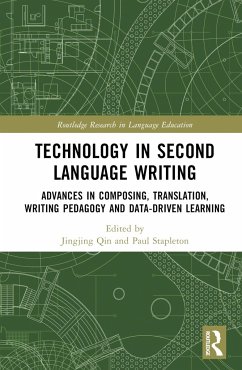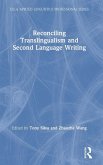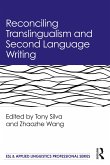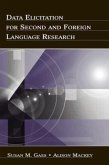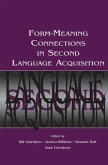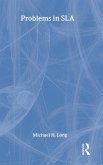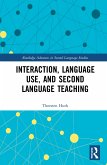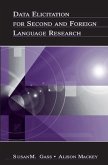Technology in Second Language Writing
Advances in Composing, Translation, Writing Pedagogy and Data-Driven Learning
Herausgeber: Qin, Jingjing; Stapleton, Paul
Technology in Second Language Writing
Advances in Composing, Translation, Writing Pedagogy and Data-Driven Learning
Herausgeber: Qin, Jingjing; Stapleton, Paul
- Gebundenes Buch
- Merkliste
- Auf die Merkliste
- Bewerten Bewerten
- Teilen
- Produkt teilen
- Produkterinnerung
- Produkterinnerung
This edited volume showcases state-of-the-art research in technological applications in second language writing. It examines multimodal composing, digital feedback, data-driven learning, machine translation and technological applications in writing pedagogy.
Andere Kunden interessierten sich auch für
![Reconciling Translingualism and Second Language Writing Reconciling Translingualism and Second Language Writing]() Reconciling Translingualism and Second Language Writing167,99 €
Reconciling Translingualism and Second Language Writing167,99 €![Reconciling Translingualism and Second Language Writing Reconciling Translingualism and Second Language Writing]() Reconciling Translingualism and Second Language Writing53,99 €
Reconciling Translingualism and Second Language Writing53,99 €![Data Elicitation for Second and Foreign Language Research Data Elicitation for Second and Foreign Language Research]() Susan M. GassData Elicitation for Second and Foreign Language Research55,99 €
Susan M. GassData Elicitation for Second and Foreign Language Research55,99 €![Form-Meaning Connections in Second Language Acquisition Form-Meaning Connections in Second Language Acquisition]() Form-Meaning Connections in Second Language Acquisition68,99 €
Form-Meaning Connections in Second Language Acquisition68,99 €![Problems in Second Language Acquisition Problems in Second Language Acquisition]() Michael H. LongProblems in Second Language Acquisition169,99 €
Michael H. LongProblems in Second Language Acquisition169,99 €![Interaction, Language Use, and Second Language Teaching Interaction, Language Use, and Second Language Teaching]() Thorsten HuthInteraction, Language Use, and Second Language Teaching167,99 €
Thorsten HuthInteraction, Language Use, and Second Language Teaching167,99 €![Data Elicitation for Second and Foreign Language Research Data Elicitation for Second and Foreign Language Research]() Susan M. GassData Elicitation for Second and Foreign Language Research185,99 €
Susan M. GassData Elicitation for Second and Foreign Language Research185,99 €-
-
-
This edited volume showcases state-of-the-art research in technological applications in second language writing. It examines multimodal composing, digital feedback, data-driven learning, machine translation and technological applications in writing pedagogy.
Produktdetails
- Produktdetails
- Verlag: Routledge
- Seitenzahl: 198
- Erscheinungstermin: 30. November 2022
- Englisch
- Abmessung: 240mm x 161mm x 15mm
- Gewicht: 467g
- ISBN-13: 9781032245805
- ISBN-10: 1032245808
- Artikelnr.: 64104581
- Herstellerkennzeichnung
- Libri GmbH
- Europaallee 1
- 36244 Bad Hersfeld
- gpsr@libri.de
- Verlag: Routledge
- Seitenzahl: 198
- Erscheinungstermin: 30. November 2022
- Englisch
- Abmessung: 240mm x 161mm x 15mm
- Gewicht: 467g
- ISBN-13: 9781032245805
- ISBN-10: 1032245808
- Artikelnr.: 64104581
- Herstellerkennzeichnung
- Libri GmbH
- Europaallee 1
- 36244 Bad Hersfeld
- gpsr@libri.de
Jingjing Qin is an Associate Professor in the Department of Language Studies at Zayed University, UAE. Paul Stapleton is an Independent Researcher. His academic interests include L2 writing, critical thinking, and research methods.
Chapter 1. Introduction: Advances in writing technology over the eons
Paul Stapleton
Chapter 2. Interactive academic EFL writing assisted by GT for Chinese
non-English major students
Shu-Chiao Tsai
Chapter 3. The use of Google Translate and complementary resources by
Chinese students: A case study writing in Catalan
Ruocheng Ning
Chapter 4. Using machine translation in EFL Writing: A scoping review
Burcu Gokgoz-Kurt
Chapter 5. Repeated academic writing with synchronous and asynchronous
teacher electronic feedback: How are macro and micro aspects affected?
Sima Khezrlou
Chapter 6. Wiki writing in medicine and students' perceptions: The case of
an English-in-the-Discipline course in Hong Kong
Wenfeng Wang, Simon Boyton, Laura Wakeland, Daya Datwani, Juan Castillo,
Letty Chan, and Simon Scanlon
Chapter 7. Multimodal resemiotization: Examining one L2 writer's
interactions with equity videos
Emma R. Britton, Hengyi Liu, Xinyue Zuo, and Theresa Y. Austin
Chapter 8. The dialogical conception of beginning L2 writing via social
networking and telecollaboration
Maria Bondarenko and Liudmila Klimanova
Chapter 9. Examining directness with corpus tools in Iraqi EFL writing
Ashleigh Cox, Eric Friginal, and Sabah S. Mustafa
Chapter 10. L2 handwritten assignments for automated writing evaluation: A
text recognition study
Vahid Abolghasemi and Reza Falahati
Chapter 11. Using computer keystroke logging in the second language
composition classroom
Hampus Holm, Etienne Skein, and Kirk P. H. Sullivan
Paul Stapleton
Chapter 2. Interactive academic EFL writing assisted by GT for Chinese
non-English major students
Shu-Chiao Tsai
Chapter 3. The use of Google Translate and complementary resources by
Chinese students: A case study writing in Catalan
Ruocheng Ning
Chapter 4. Using machine translation in EFL Writing: A scoping review
Burcu Gokgoz-Kurt
Chapter 5. Repeated academic writing with synchronous and asynchronous
teacher electronic feedback: How are macro and micro aspects affected?
Sima Khezrlou
Chapter 6. Wiki writing in medicine and students' perceptions: The case of
an English-in-the-Discipline course in Hong Kong
Wenfeng Wang, Simon Boyton, Laura Wakeland, Daya Datwani, Juan Castillo,
Letty Chan, and Simon Scanlon
Chapter 7. Multimodal resemiotization: Examining one L2 writer's
interactions with equity videos
Emma R. Britton, Hengyi Liu, Xinyue Zuo, and Theresa Y. Austin
Chapter 8. The dialogical conception of beginning L2 writing via social
networking and telecollaboration
Maria Bondarenko and Liudmila Klimanova
Chapter 9. Examining directness with corpus tools in Iraqi EFL writing
Ashleigh Cox, Eric Friginal, and Sabah S. Mustafa
Chapter 10. L2 handwritten assignments for automated writing evaluation: A
text recognition study
Vahid Abolghasemi and Reza Falahati
Chapter 11. Using computer keystroke logging in the second language
composition classroom
Hampus Holm, Etienne Skein, and Kirk P. H. Sullivan
Chapter 1. Introduction: Advances in writing technology over the eons
Paul Stapleton
Chapter 2. Interactive academic EFL writing assisted by GT for Chinese
non-English major students
Shu-Chiao Tsai
Chapter 3. The use of Google Translate and complementary resources by
Chinese students: A case study writing in Catalan
Ruocheng Ning
Chapter 4. Using machine translation in EFL Writing: A scoping review
Burcu Gokgoz-Kurt
Chapter 5. Repeated academic writing with synchronous and asynchronous
teacher electronic feedback: How are macro and micro aspects affected?
Sima Khezrlou
Chapter 6. Wiki writing in medicine and students' perceptions: The case of
an English-in-the-Discipline course in Hong Kong
Wenfeng Wang, Simon Boyton, Laura Wakeland, Daya Datwani, Juan Castillo,
Letty Chan, and Simon Scanlon
Chapter 7. Multimodal resemiotization: Examining one L2 writer's
interactions with equity videos
Emma R. Britton, Hengyi Liu, Xinyue Zuo, and Theresa Y. Austin
Chapter 8. The dialogical conception of beginning L2 writing via social
networking and telecollaboration
Maria Bondarenko and Liudmila Klimanova
Chapter 9. Examining directness with corpus tools in Iraqi EFL writing
Ashleigh Cox, Eric Friginal, and Sabah S. Mustafa
Chapter 10. L2 handwritten assignments for automated writing evaluation: A
text recognition study
Vahid Abolghasemi and Reza Falahati
Chapter 11. Using computer keystroke logging in the second language
composition classroom
Hampus Holm, Etienne Skein, and Kirk P. H. Sullivan
Paul Stapleton
Chapter 2. Interactive academic EFL writing assisted by GT for Chinese
non-English major students
Shu-Chiao Tsai
Chapter 3. The use of Google Translate and complementary resources by
Chinese students: A case study writing in Catalan
Ruocheng Ning
Chapter 4. Using machine translation in EFL Writing: A scoping review
Burcu Gokgoz-Kurt
Chapter 5. Repeated academic writing with synchronous and asynchronous
teacher electronic feedback: How are macro and micro aspects affected?
Sima Khezrlou
Chapter 6. Wiki writing in medicine and students' perceptions: The case of
an English-in-the-Discipline course in Hong Kong
Wenfeng Wang, Simon Boyton, Laura Wakeland, Daya Datwani, Juan Castillo,
Letty Chan, and Simon Scanlon
Chapter 7. Multimodal resemiotization: Examining one L2 writer's
interactions with equity videos
Emma R. Britton, Hengyi Liu, Xinyue Zuo, and Theresa Y. Austin
Chapter 8. The dialogical conception of beginning L2 writing via social
networking and telecollaboration
Maria Bondarenko and Liudmila Klimanova
Chapter 9. Examining directness with corpus tools in Iraqi EFL writing
Ashleigh Cox, Eric Friginal, and Sabah S. Mustafa
Chapter 10. L2 handwritten assignments for automated writing evaluation: A
text recognition study
Vahid Abolghasemi and Reza Falahati
Chapter 11. Using computer keystroke logging in the second language
composition classroom
Hampus Holm, Etienne Skein, and Kirk P. H. Sullivan

